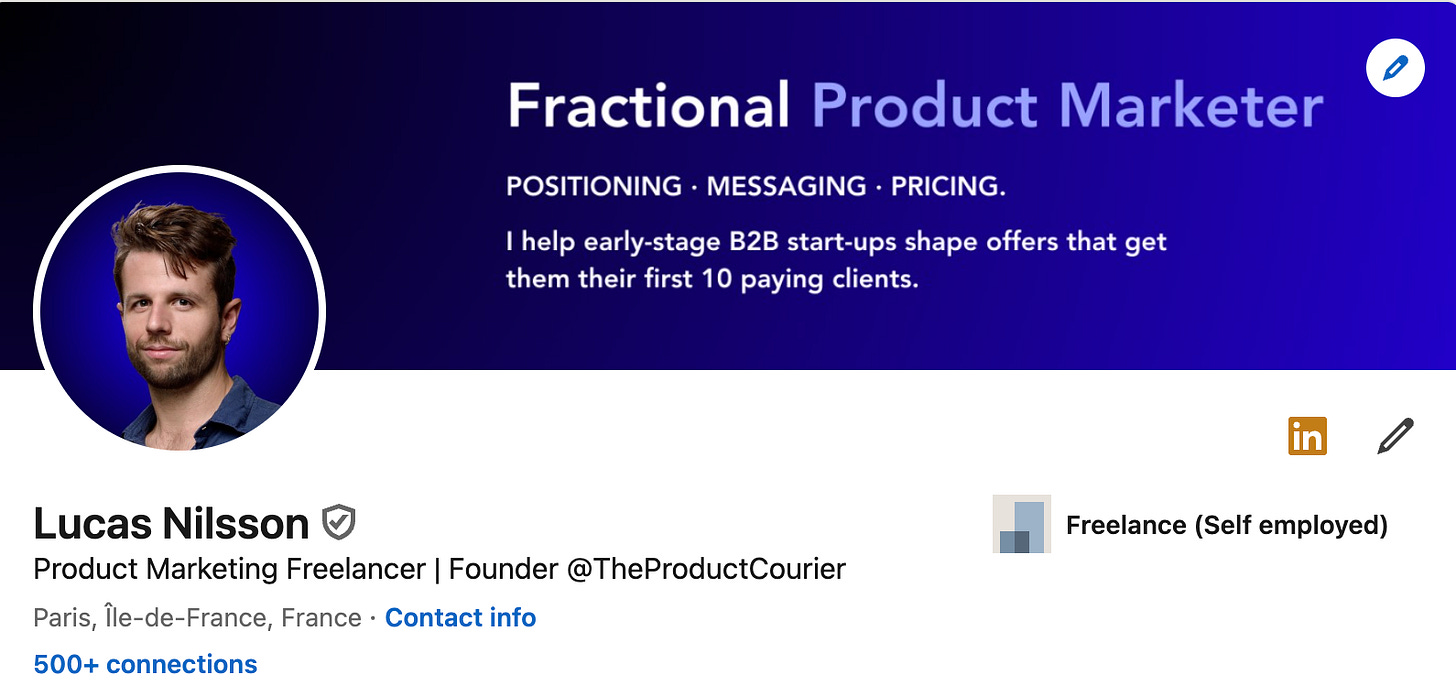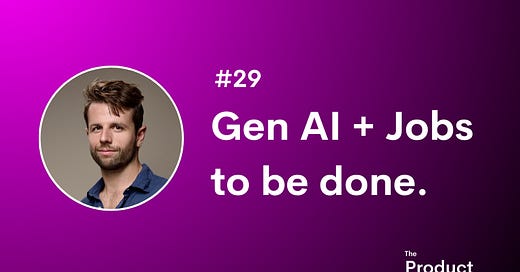How AI can help you understand what users truly want.
How I use ChatGPT to instantly get a better understanding of my users + my personal prompt.
Thank you for reading The Product Courier!
We’re 1,660 here, which is 120 more than last month! 🚀
If you're new here, welcome! I’m Lucas Nilsson, a Product Marketing Freelancer who helps early-stage startups frame offers that get them their first 10 clients.

With my partner, Toni Dos Santos, who’s also a freelancer in Product Management, we share every week hands-on tutorials to help you deliver better work and speed up your career, by leveraging A.I. and other tools.
In this 29th edition, we’ll talk about:
Anthropic latest feature, that allows Claude to take control of your computer. 🤯
How to use AI + Jobs to be done to get a better understanding of your users. (+ my personal prompt) 🧰.
Make sure you subscribe to not miss our next tutorials!
But first, you should definitely have a look at this event:
Scaleway is once again organizing ai-PULSE, its groundbreaking conference designed to further European AI… and the event is already filling up fast!
Why?
👉🏻 Visionary keynotes from the world’s biggest AI thought leaders.
👉🏻 Technical workshops by experts from Kyutai, Poolside, Doctolib, and many more.
👉🏻 A unique focus on three main tracks: Large models, Efficient models, and Open source models
👉🏻 Networking with Europe’s AI crème de la crème!
Visitors can join onsite (places limited), or watch online.
Interested? Get your ticket below!
Thank you Scaleway for sponsoring this newsletter.
News of the week. 📰
Claude can now control your computer screen. 🤯
AI hype might be overinflated, yet every week when I write this newsletter, it only takes me about 10 seconds to find a great update to focus on.
This week, for example, Anthropic released a feature that interacts directly with your computer. Essentially, this feature allows their LLM, Claude, to take control and interact directly with your apps.
Here’s an example video from Anthropic, where the original task was to create a 90s-style website for Claude.
Claude opens Chrome.
Searches for claude.ai.
Creates a prompt asking Claude to generate the HTML code.
Claude returns the code and downloads the file.
Opens VSCode and finds the file in the Downloads folder.
Open it and start modifying the code.
I won't go into every detail, but you get the idea: Claude interacts with the computer autonomously, switching between apps to actually execute the task.
This gives a sneak peek of what AI agents might look like in the future: partially autonomous apps, able to gather information scattered across the internet and local files, and capable of self-resolving blockers.
Here are a few use cases for Product or Marketing:
Auto-generate product comparison sheets
Pull data for competitive analysis from websites
Format and structure documentation
Organize customer feedback data from different sources
The feature is still in beta and only available through their API.
Can you imagine how powerful this would be when combined with an advanced voice mode? 🤯
Community Polls. 📊
Your weekly tutorial. 🧰
How to better understand what user truly want with AI.
In nearly every failed startup, the real problem is that customers didn't want the product.
Paul Graham
Most companies fail because they don’t get the fundamentals right.
They build products nobody asked for, needed, or even wanted.
In my freelancing work, I speak with early-stage founders every week. In the first months of their entrepreneurial journey, they all make the same mistake:
Creating a product based on their own vision, often disconnected from actual customer concerns and practices.
Which, unsurprisingly, doesn’t bring great results. 🤷
There’s no single way to successfully build and launch a product.
But focusing on customer use cases, needs, and psychological aspects helps a lot. That’s kind of "Product 101," right?
Yet, I see products fail every day.
Most of the time, it’s because they only scratch the surface of their customer research.
The Jobs-to-be-Done framework is a great way to avoid this mistake.
I use it frequently because it keeps me connected to my customers' needs and helps me gain a better understanding of what my clients really want.
What’s the Job to be done method?
The Jobs-to-be-Done (JTBD) method is a powerful tool for understanding why users make certain choices. It’s about uncovering the real context behind how and why a product is used.
This method is based on the idea that people "hire" a product to do a specific "job."
Through research, we often realize that people use tech products for a variety of reasons, and too often we only scratch the surface in understanding these reasons. It turns out, sometimes they buy for completely different reasons than expected.
Here’s a real-world example from McDonald's:
Problem: McDonald's milkshake sales were stagnant despite adding various flavors.
JTBD Approach: They researched why customers were purchasing milkshakes, focusing on why users were specifically "hiring" McDonald's.
Findings:
They realized that 50% milkshakes were bought before 8:30 AM by morning commuters on their way to work.
The "job" was that people were buying these milkshakes because they were thick and lasted through the entire drive. They were also very filling.
Actions Implemented: Made milkshakes even thicker to last longer and added ingredients to increase satiety.
Result: Significant increase in morning sales.
By focusing on the underlying motivations, you can identify the real "jobs" users hire products to do, rather than relying on logical deduction and intuitions.
Shifting from building products to solving customer problems.
The JTBD framework involves asking questions like:
What are users trying to accomplish?
What barriers are they facing?
What motivates them to change their existing behavior?
In other words: What are they struggling with (context), and what are they trying to achieve (outcome)?
However, effectively using the JTBD framework requires a deep understanding of your users—which can be challenging because:
You rarely have enough time to quickly conduct 8-12 qualitative interviews with your users.
Users themselves may struggle to fully understand or articulate what they need.
That’s where GenAI can help.
How GenAI can help.
Most GenAI models are extremely efficient at providing a quick and comprehensive picture of your product's use cases and the psychological aspects involved.
This is great if you:
→ Are starting work on a new product.
→ Don’t have time for thorough customer discovery.
→ Need an easy way to explain your product's use cases to your team.
It won't replace customer interviews, but it can help you get a solid surface-level understanding of the jobs related to your product in just a few seconds.
Here’s an example of the output you can get from ChatGPT, along with the prompt I used to:
Identify my product’s customers' "Jobs"
Determine their desired outcomes
Pinpoint their struggles
Get insights for future product improvements
Using ChatGPT + JTBD to get a better understanding of my customer needs.
For this example, I focused on Observability, a cloud resource monitoring tool, specifically for small and medium businesses (SMBs). I asked ChatGPT to help me:
Here’s the results I got + the prompt I used (you just have to copy/paste in your own ChatGPT account)👇
[This section is exclusive to paid subscribers. ❤️]
Here's what you gain when you subscribe to The Product Courier. 💪
Receive 4x articles and tutorials each month.
Access 1 Members-only Q&A session each month with us.
Network with our exclusive community of premium users.
Get privileged access to 1:1 coaching for tailored productivity strategies.
Be a board advisor on the future content in The Product Courier.
Get unlimited access to our prompt library (for annual subscribers only).
Subscribe now and get instant access to this tutorial!





